
Grab a can of paint.
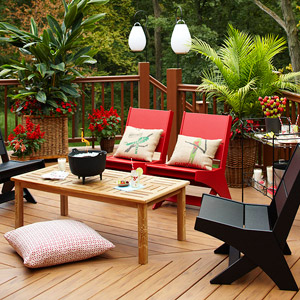
This gardener found a lavender blue that he loved and then used it extensively throughout the garden, painting doors, fences, pots, garden furniture, and even a small dead tree in the rich color.
Especially in a small garden, painting several items the same intense color creates continuity and punch. Even in deepest winter, the garden will be colorful and interesting.
Other colors that do well in gardens include magenta, teal, deep purple, spring or lime greens, deep sunny yellow, and brick reds.
Nearly any quality oil-based or latex-based paint will do, whether it’s in a bucket or a spray can. Just be sure to choose an exterior-grade paint. And if you’re painting metal, choose one that’s rust-resistant.
continue reading below
Make it fabulous with fabric.
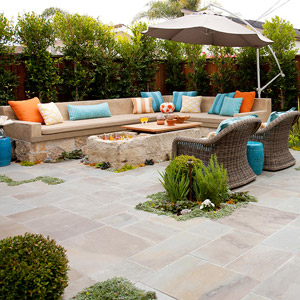
A little fabric can work miracles. A piece of it stitched into a tablecloth can turn a decrepit picnic table or even an aged card table into an inviting dining spot. A few pillows can turn an old bench into a garden retreat. And a slipcover or two can revitalize world-weary garden furniture.
Too many people think it’s a no-no to use fabrics outdoors, but that’s not the case. Seek out inexpensive fabrics on clearance, remnants, or recycle sheets and consider the fabrics semi-disposable. Leave ’em out in the rain and then let the sun dry them again. They’ll last just a year or two, but then you’ll be free to start with a fresh look all over again.
The other alternative is to invest in good, rugged, exterior-quality fabrics, found at most fabric shops. They resists fading and mildew, and will be around for years.
Play around with concrete paint.
A relatively new product, concrete paint has been the savior of many a boring concrete slab patio or ho-hum front walk.
It comes in a wide range of colors and adds interest and warmth to even old, cracked concrete. Paint, for example, a concrete-slab patio in a gray and green checkerboard pattern. Run a rich blue strip up your front steps, bordered in two deep red stripes. Or give your driveway a warm glow by painting it a deep umber.
Come up with any pattern you desire. You can patch cracks and chips if you want, but some of the most interesting projects incorporate those flaws into the design.
Painting concrete is just about as easy as painting a wall. First wash down the surface with diluted muratic acid, and use a stiff brush to remove all traces of dirt and grime.
Once the concrete is dry, mark out your pattern with masking paint and pencil marks. Paint with regular brushes, using small brushes for more detailed patterns. Allow to dry thoroughly for a day or two, then seal with an oil-based sealer. You can even tint the sealer, if desired, to add more richness to the color.
Add your own inexpensive structure with a landscaping timber bed.
Collect cool stuff.
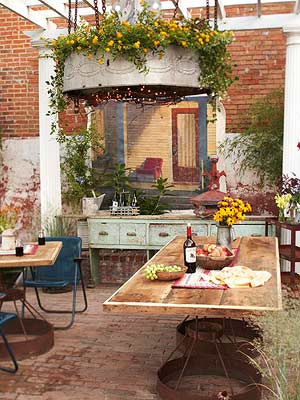
Nothing adds character to a garden faster and more reliably than collectibles.
Whether it’s birdhouses, vintage garden tools, weathered watering cans, baskets, birdcages, statuary, vintage trellises, or even old sporting equipment, these items picked up at antique stores and flea markets look good no matter what the weather. And they don’t need watering or weeding — a plus for any busy gardener.
Some rules do apply. To prevent a chaotic, hodge-podge look, keep some common themes among your collectibles. Perhaps all of them will have a rusty, oxidized surface. Or all will be birdhouses. Or all will be made of weathered natural wood.
Cluster groups of collectibles together, displaying them in much the same way you would in your home. A grouping of old hand tools, for example, would look great artistically arranged and hung by nails on the side of the garage. A display of old watering cans might look good lined up on a simple bench or hung in a row along a tall privacy fence.
As fun as it is to use collectibles, it’s also important to limit yourself. The garden should be more about plants than about stuff, so exercise restraint and limit yourselves to favorite pieces displayed in moderation.
Dig a front flower bed.
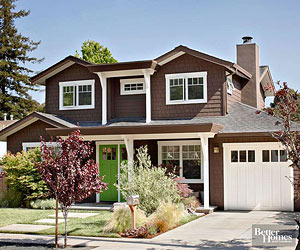
Give over a weekend to digging a deep, curving flower bed around the front of your house and you’ll not only beautify your home but improve its value as well.
Front flower beds are eye-catchers and enhance what real-estate agents call “curb appeal.”
Make the bed deep enough — anywhere from 3 to 6 feet deep — to have an effect. Fill it with shrubs along the back next to the house and a few long-blooming perennials.
Get the secrets to a fabulous front yard landscape.
Go pot crazy.
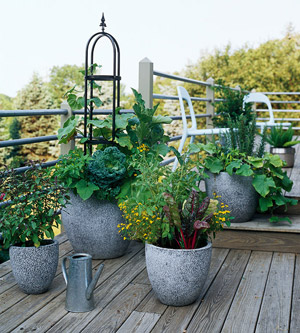
Pots of plants solve so many problems. They dress up a plain entry. They add color and greenery to barren concrete corners and blah back doors. They pretty up porches and patios.
Investing in a large collection of pots can set you back, but buying just a few each year is within the reach of just about everyone.
Focus on purchasing pots that go with one another, those made of a similar material or some other unifying theme. If you have a collection of disparate pots, paint them all the same color (there is now a special paint especially for clay pots).
Your collections of pots will be even more striking if you scatter in among them little accents, such as small sculptures or even something as simple as a pretty stone.
Get creative with salvaged objects.
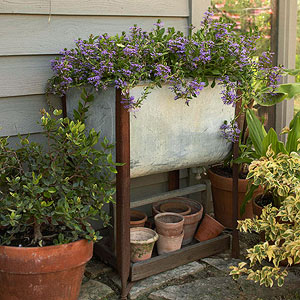
Don’t throw it out — find a new use for it in your garden. Whether you have leftovers from a home project or you’ve been lucky in dumpster diving, architectural remnants (such as these old windows shown here) and other odds and ends add that much-touted “structure” to the garden.
See creative ideas on using salvaged materials as containers.
More Ideas:
- Hang a mirror. It adds glitter and light to a space and can reflect a nice view. Just be sure to hang it in a somewhat protected spot, such as under an overhang.
- Hinge old doors together to make an outdoor screen, great for hiding garbage cans or a compost heap.
- A rickety chair can be given new life as a small trellis. Plunk it right down directly in a flower bed and plant with a vine.
- Old weathered wood looks great in the garden. Weathered lumber, salvaged from the dump or a demolition project, is easy to turn into a simple bench or potting table and will look as though it’s always been in your garden.
- A secondhand dresser, especially if it has chipped and peeling paint, looks surprisingly at home in the garden. Put it up against a wall and use it as a potting bench. The drawers make for excellent storage.
See even more ideas on using salvaged materials in the garden.
Learn practical ways to landscape yards without grass.
More Ways to Boost Your Budget
Plants that Give You the Most Bang for Your Buck
-
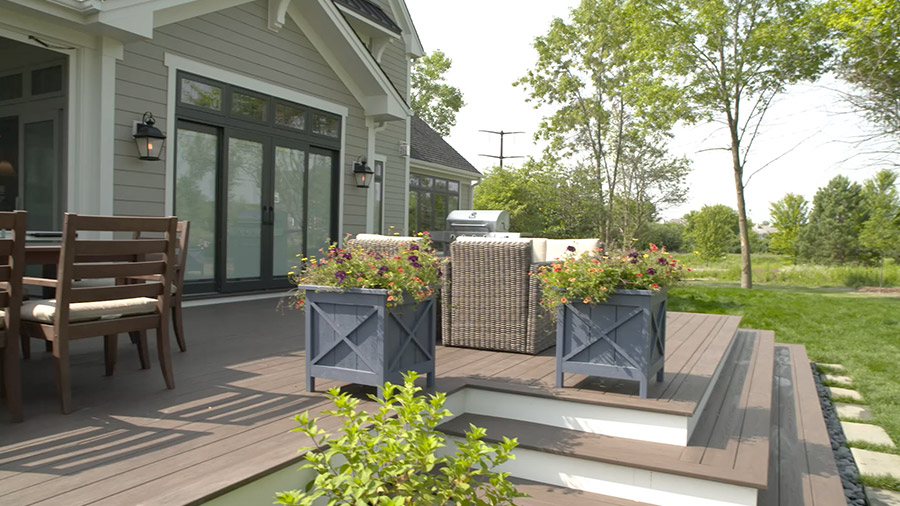
How to Prioritize Your Landscaping Budget
-
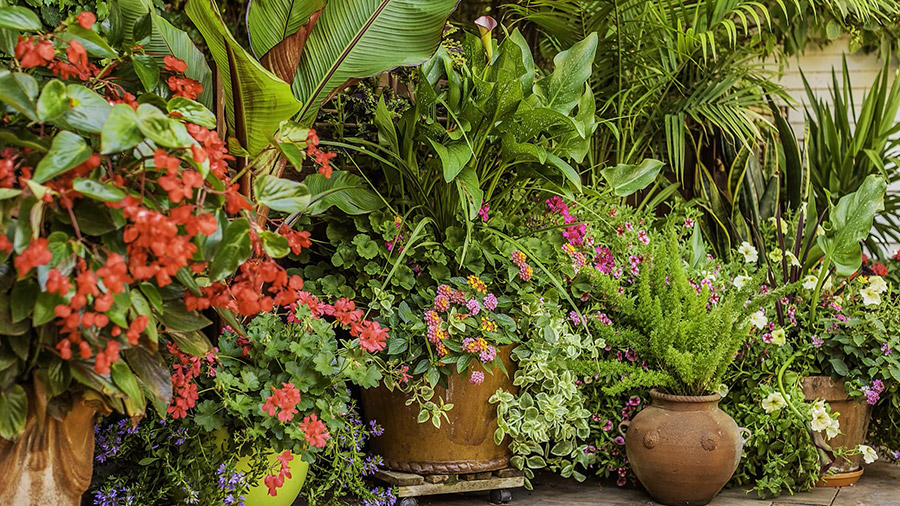
The Biggest Wastes of Landscaping Dollars
SOURCE:http://www.bhg.com/gardening/landscaping-projects/landscape-basics/budget-landscaping/